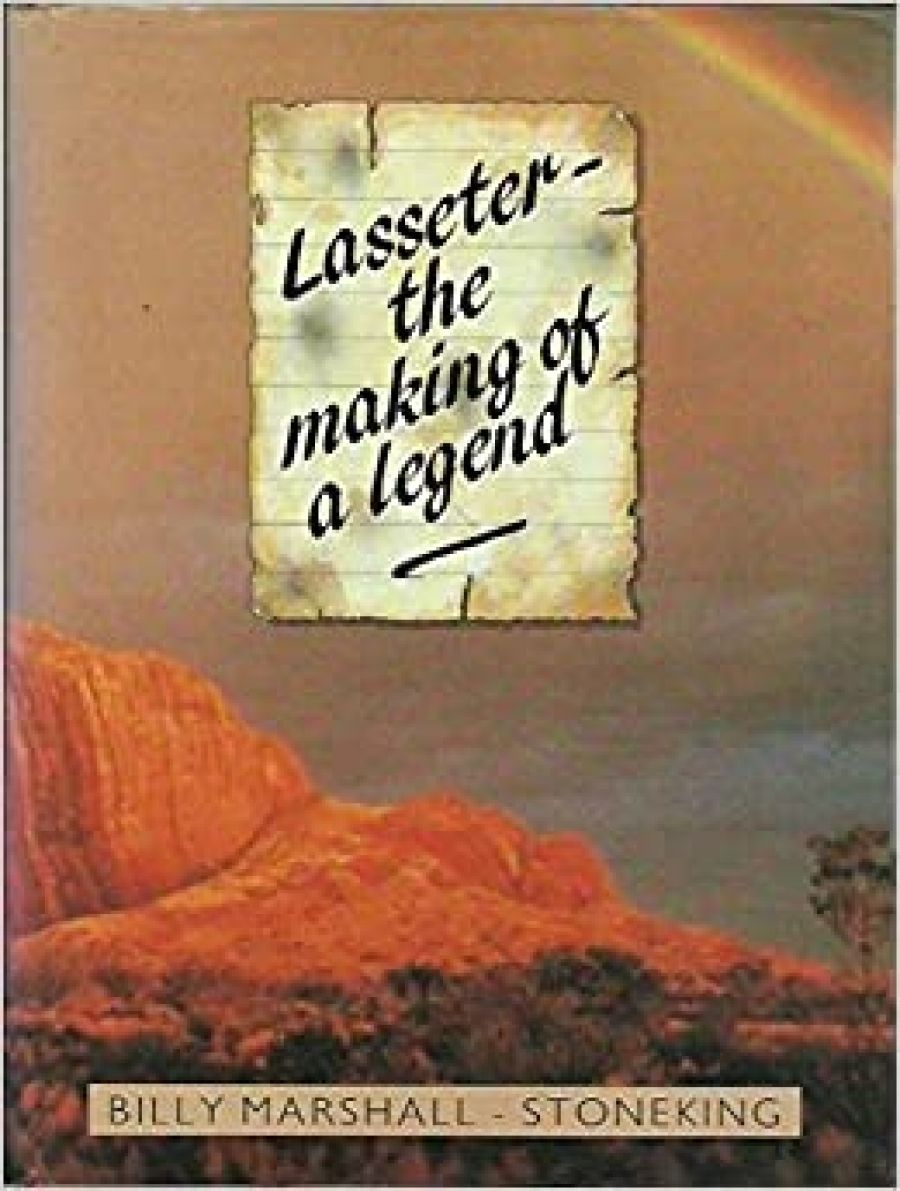
- Free Article: No
- Contents Category: Australian History
- Review Article: Yes
- Online Only: No
- Custom Highlight Text:
The legend of Lasseter’s Reef is a strand of Australian folklore that has been transformed from its original oral state largely through the fascination of the mass media with the events of 1930–31, and with lost treasure tales in general. A number of books, newspapers, and magazine articles, together with some fiction and documentary films have been produced on the Lasseter story. In fact it was the 1956 Hollywood ‘B’ movie, Green Fire, (about fabled treasure in South America) that first sparked Billy Marshall-Stoneking’s long interest in Lasseter.
- Book 1 Title: Lasseter
- Book 1 Subtitle: The making of a legend
- Book 1 Biblio: George Allen and Unwin Australia, 200pp, illus., $24.95hb
Among its many other attributes, film is a potent mythologiser, a form that almost inevitably conflates ‘fact’ and fiction, reality and illusion. The author of this latest offering on Lasseter seems to have done much the same thing. Not that this is necessarily a criticism of the book. Although there are certainly criticisms that need to be made, by and large Lasseter: The Making of a Legend is a worthwhile and readable attempt to unravel the essential details of the story as it has developed over the last fifty-odd years.
First the criticisms. When a work claims to be ‘the definitive history’ of anything I always begin wondering how history can ever be definitive. Less idiosyncratically I also expect the so-trumpeted work to display a pretty rigorous degree of historical methodology. Although Mr Marshall-Stoneking has done most of his homework there are a number of crucial lapses. The most worrying of these is his almost total reliance on a number of secondary sources which he himself labels ‘dubious’ or otherwise casts considerable doubts upon.
Linked with this is the general unreliability and ambivalence of those primary sources that are used, Lasseter’s diary and letters, for instance. This is hardly the author’s fault, though it is his problem. He seems content to note the inconsistencies in the evidence without attempting to counter or even acknowledge their undermining effect on the narrative and interpretation he constructs.
It also seems that Mr MarshallStoneking’s inspiration by, and apparent interest in, mass media mythologising, has led him to present as history those central elements of the Lasseter story that are the classic motifs of ‘lost treasure’ tales. In the Lasseter saga presented here we have mention of a map locating the fabulously rich treasure in an inaccessible place and of unaccountably mysterious meetings between Lasseter and Fred Blakely (expedition leader); documents revealing the true position of the fabled reef (one written in invisible ink!) are deposited with ‘a Sydney bank’ (which one we are not told, and the only subsequent mention of these documents informs us that the bearings given were – surprise – ‘incorrect’); various unexplained accidents and disasters befall the expedition as it travels through areas sacred to the local Aboriginal tribes; one of the members of the expedition unwittingly accepts an Aboriginal Tjuringa and takes it back to England where various members of his family mysteriously die (shades of the Curse of the Mummy); there are numerous reports of Lasseter’s supposed survival in Australia and America (the hero lives on after his supposed, death – compare with King Arthur, Dan Kelly, and Jesus Christ, to name only a notable few), and finally we are told of the possible existence of two last diaries. By not recognising and accounting for the distinctions between history and folklore this book tends to further the mystification of that part of the past concerning Lasseter’s reef. There is nothing mysterious about greed.
The strengths of the book are the generally well-crafted narrative with its appropriately anecdotal style. Occasionally Billy Marshall-Stoneking’s writing is highly evocative of that part of Central Australia where Lasseter (or someone) met his end, reflecting the author’s own experience of the country. The most important facet of the book is that someone has at last talked to the people who know more about Lasseter’s fate and the land where he met it than anyone. The Aboriginal oral accounts collected by Mr Marshall-Stoneking are a valuable addition to the story, though like the white accounts are usually contradictory. It seems that Lasseter has passed into Aboriginal folklore as well as into that of white Australia. As the author says, ‘The story of Lasseter has been told and retold and, it would appear, comes very close to the status of a Dreamtime tale’. In addition, Shorty Lungkarta, an elderly man of the Pintupi Aborigines, says ‘That Lasseter, that’s a whitefella dreaming’. The most appropriate last words of all, although it is unlikely that they will be the last we’ll hear about Lasseter and his reef, either in fact or fiction.


Comments powered by CComment